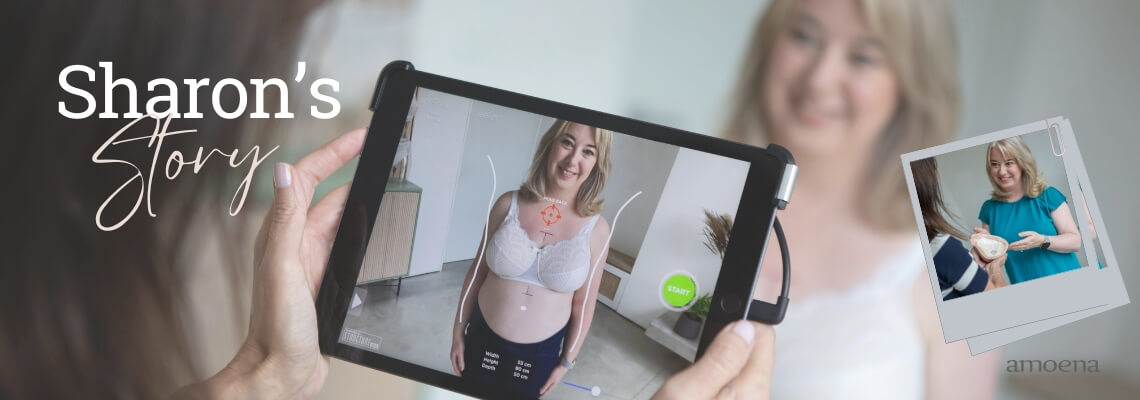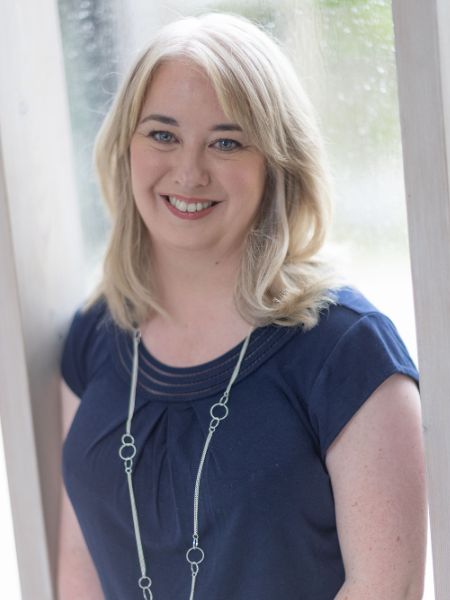Menu
Skip to main content

Basket
Search
Country

The perfect match
When only a made-to-measure breast form will do
If you’ve ever wondered what it would be like to have a breast form made specifically for you, read on. We talked to Sharon about why Amoena’s new Custom-fit breast form felt so right for her.
Breast form technology has advanced so much since the mid-1970s that it’s possible to find just the right fit for almost everyone, whatever their surgery type. But there are some women who find it difficult, if not impossible, to get the perfect fit from an off-the-shelf prosthesis. This could be due to a number of factors, including the shape of their chest wall, uneven scarring, or because they’ve had to undergo several procedures.
Coping with the trauma of breast cancer treatment is challenging enough, but if you’re left feeling that you will never again be comfortable in your own skin it can be devastating.
Since Amoena pioneered the very first silicone breast form, the company has been at the forefront of product development, harnessing the very latest technology to push the boundaries of what a breast form can be. And the latest addition to the Amoena portfolio, the Custom-fit breast form, is the most ambitious yet.
Quite simply, the Custom-fit breast form is a bespoke item that’s created using 3D imaging and produced at Amoena’s headquarters in Germany to each woman’s precise measurements, needs and specifications. No two Custom-fit breast forms are alike, just as a bespoke dress, handbag or piece of jewellery will be unique to the individual who commissioned it.
The fit, needless to say, is as close to perfect as you can imagine. The comfort level is exceptional: wearers report that within less than two weeks of receiving their Custom-fit form, they completely forget they’re wearing one. “This is so much more important than it might at first seem,” says Sharon, who has been wearing her Custom-fit Contact breast form since January 2023. “When your breast form is a perfect fit, it’s as if your body can relax. Your brain gets the signal that you’re ‘whole’ again, and you feel you can leave behind so many of the anxieties you’ve been carrying around since your breast surgery. There really is nothing to beat that feeling.”
And this, perhaps, is why the Custom-fit breast form is also gaining a following among discerning women who prefer to have a bespoke prosthesis designed for them alone, no matter what their surgery type.
 Surprise diagnosis
Surprise diagnosis
Sharon’s diagnosis came as a complete surprise. Late in 2021, when she was a couple of months away from her 43rd birthday, a Covid jab resulted in a slight swelling under her left arm and her GP recommended an ultrasound scan. At the clinic she was told the swelling was normal and would reduce but, she says, “They also scanned my right side and what they saw there led them to recommend a biopsy, which was a real shock.”
The biopsy was in early December and Sharon had to wait until the end of the month to get the results: “Although I knew this didn’t necessarily mean I had breast cancer, over Christmas it started to worry me more. I just had a feeling that it wasn’t going to be good news.”
She opted for private medical treatment through her husband’s, and later her own, medical insurance, so her subsequent experiences won’t necessarily be the same as those of women treated via the NHS.
At her appointment with a breast surgeon to discuss the results of her biopsy, he told her: “Some of these come back OK. Yours is one of those that didn’t.” He recommended a lumpectomy in the upper quadrant of the breast, with autologous reconstruction using a LICAP procedure. This takes skin and fat from the chest wall and back to replace lost breast tissue. Sharon wasn’t offered any other options: “That really was the plan. There wasn't anything else tabled at that time.”
Unfortunately for Sharon she experienced skin necrosis and seroma, although this was not identified by her care team, resulting in her being admitted to A&E more than once with serious complications.
After this, due to positive margins, she was told she would need a full unilateral mastectomy. She hoped she would be able to have surgery that would leave loose skin to enable her to have expander implant reconstruction at a future date. Regrettably, however, she was given a flat closure mastectomy and there may not be enough skin to stretch. “They told me this was because I’d had previous complications,” she says, “but the impact on my options after surgery wasn’t fully explained to me beforehand.”
Non-surgical reconstruction
Although Sharon was discharged by her surgeon with only hormone therapy follow-up and did not require chemotherapy or radiotherapy, she is still exploring ways in which she might be able to have breast reconstruction.
“Reconstruction isn’t quite as straightforward for me as it may be for most women. I’ve spoken to quite a few different surgeons about it and I’m currently waiting for an opinion from a specialist surgeon at St Thomas’s Hospital in London.
“At the outset, like the majority of patients, I was hoping to have tissue expanders and implants, but this might not be possible now. So when you start to explore what remains, you’re looking at a potential DIEP flap or one of the newer technologies, like tissue scaffolds in combination with fat grafting.”
Fat grafting can be less demanding on the body than other types of reconstructive surgery, but it has its limitations – for example it can only create a new breast up to around a C cup size. Sharon also has an underlying condition which means repeated surgeries are not ideal for her.
This, together with an irregular bone formation in her chest which makes it challenging to find a standard breast form that fits properly and matches the other side, led her to look at the possibility of a custom-made form. “It felt like one of the options I had was a non-surgical reconstruction. That’s basically the way I viewed it.”
Investing upfront

Sharon got to know the team at Amoena UK’s Southampton Shop when she was fitted after her initial surgery. “Meeting the team at Amoena is always really special. You can’t capture what they have and you can’t buy it. They really care about what they do."
“I started off with a softie, which I guess everybody does. Then when I went to Amoena I remember the lovely lady was going through all the breast form options but I was quite focused on the Adapt Air, which I’d read all about. Because of my chest wall deformity I thought it sounded just right. But while I waited for that to arrive, I ordered a Natura Cosmetic with a soft silicone back, which was really good for wearing just after surgery.
“I also remember asking about the Contact breast form, which adheres directly to the body and therefore seemed ideal. But unfortunately it was too soon after my surgery to be fitted with this, so in the end Adapt Air was best, because I could adjust the back for a closer fit.”
Still convinced she could find an even better solution, Sharon started researching custom-made breast forms created using 3D scanning technology. Around this time, her niece, who works in the film industry producing special effects and prosthetics, offered to use the technology to design a breast form for Sharon. “It sounded very exciting, and it got me looking further into the 3D scanning concept.”
As part of her investigations, Sharon saw the Custom-fit breast form on Amoena’s USA website and subsequently found out it was soon to be launched in the UK. Convinced this could be the solution she needed, she decided to go ahead. “I had been wearing Amoena breast forms since my surgery and found them to be a great fit – particularly the Adapt Air,” she says. “But the idea of a custom-made form was very exciting indeed.
“I thought back to when I was in hospital. The only information I had about what might be about to happen to me and how I was going to cope with it was Amoena’s recovery care post-surgery leaflet. I remember thinking that Amoena was investing in patients upfront and that the products would be of a high quality.”
Sharon believes it’s important for all women to know what might happen to them if they’re diagnosed with breast cancer. “It’s something that I think should be taught in schools,” she says. “Right now there’s no familiarisation process at all; it’s all rather taboo. The first time most women see a breast form is after they’ve had breast cancer surgery – at least, that’s how it was for me. When I was in hospital, a breast care nurse brought one over to me and placed it flat on a table. It just looked horrible, all wrinkled, and I remember thinking ‘please take that chicken fillet away’! It wasn’t until I went to Amoena for my initial fitting that I saw how lifelike a breast form could be when worn, and began to understand about texture, drape, and passing the hug test.”
As part of her fitting process for the Custom-fit breast form, Sharon had an initial consultation at Amoena’s offices near Southampton to discuss her expectations and introduce her to the scanning process. She then had to wait for about six weeks before returning for her fitting. “The whole thing was so smooth and easy,” she says. “I was impressed by how responsive the team at Amoena were to my needs.”
As close as it gets
Despite being much more familiar with wearing breast forms by the time her Custom-fit form arrived, Sharon was unprepared for her reaction. “I remember looking at it and thinking ‘Yes, this is me. This is the part that’s missing. This is as close as I will get to being the way I was without more surgery,’ and that was just phenomenal.
“One of the problems with my chest deformity is that, if I wear a standard breast form, when I look down, I can see a slope. My natural breast sits slightly forward when compared to the breast form. But as soon as I put my Custom-fit form on, I got that nice straight line.
“And it was just that instant feeling that it’s back. My body is back to the way it should be. My brain takes it all in and says, ‘it’s a match – OK good, we don’t need to worry about that anymore.’ When it fits that closely to your body, it just feels so secure. And after a couple of weeks you simply start to forget it’s there. I really believe it’s transformative.”
Sharon opted for two Custom-fit breast forms – Adapt Air and Contact. “I thought Adapt Air, with its adjustable back, would be perfect for me, and I enjoyed wearing the regular version. I had to wait until my scars had fully healed before trying Contact but I actually think it’s the one that has made the most difference. Contact gives you that feeling that there’s nothing to worry about – it’s secure and part of your body. So I think that’s the one.”
She was also delighted when her husband said it passed the hug test. “Yes, it did! He’s actually sensitive enough that he picked up that the Adapt Air is slightly firmer – but then, he’s been involved on the whole journey.”
Sharon is also surprised that she can wear the type of lingerie and clothing she wore before surgery. “I thought I would send a lot of my clothes to the charity shop because things like V-necklines would be out. But I’ve just bought myself a V-neck dress and I’m feeling confident enough to wear it. So yes, it gives you that confidence that you’ve got the choice again.”
Sharon is still reviewing her options as regards further surgery, but she is delighted with what she calls her ‘non-surgical reconstruction’. “It’s like the final, missing piece of the jigsaw.”
The Amoena Custom-fit breast form launches in the UK this October. For more information, go to www.amoena.co.uk/custom-fit.
Watch our interview with Sharon here.
Watch our video here.
Find out more: https://www.amoena.co.uk/custom-fit





